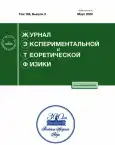Hall Effect in Doped Mott–Hubbard Insulator
- Autores: Kuchinskiy E.Z1, Kuleeva N.A1, Sadovskiy M.V1, Khomskiy D.I2
-
Afiliações:
- Institute for Electrophysics, Ural Branch, Russian Academy of Sciences
- II Physikalisches Institut, Universität zu Koeln
- Edição: Volume 163, Nº 3 (2023)
- Páginas: 417-427
- Seção: Articles
- URL: https://journals.rcsi.science/0044-4510/article/view/145279
- DOI: https://doi.org/10.31857/S0044451023030136
- EDN: https://elibrary.ru/QFDCRI
- ID: 145279
Citar
Texto integral
Resumo
We present theoretical analysis of Hall effect in doped Mott–Hubbard insulator, considered as a prototype of cuprate superconductor. We consider the standard Hubbard model within DMFT approximation. As a typical case we consider the partially filled (hole doping) lower Hubbard band. We calculate the doping dependence of both the Hall coefficient and Hall number and determine the value of carrier concentration, where Hall effect changes its sign. We obtain a significant dependence of Hall effect parameters on temperature. Disorder effects are taken into account in a qualitative way. We also perform a comparison of our theoretical results with some known experiments on doping dependence of Hall number in the normal state of YBCO and Nd-LSCO, demonstrating rather satisfactory agreement of theory and experiment. Thus the doping dependence of Hall effect parameters obtained within Hubbard model can be considered as an alternative to a popular model of the quantum critical point.
Sobre autores
E. Kuchinskiy
Institute for Electrophysics, Ural Branch, Russian Academy of Sciences
Email: kuchinsk@iep.uran.ru
620016, Yekaterinburg, Russia
N. Kuleeva
Institute for Electrophysics, Ural Branch, Russian Academy of Sciences
Email: strigina@iep.uran.ru
620016, Yekaterinburg, Russia
M. Sadovskiy
Institute for Electrophysics, Ural Branch, Russian Academy of Sciences
Email: sadovski@iep.uran.ru
620016, Yekaterinburg, Russia
D. Khomskiy
II Physikalisches Institut, Universität zu Koeln
Autor responsável pela correspondência
Email: khomskii@ph2.uni-koeln.de
50937, Koeln, Germany
Bibliografia
- Y. Iye, J.Phys.Chem. Solids 53, 1561 (1992).
- F. F. Balakirev, J.B. Betts, A. Migliori, I. Tsukada, Y. Ando, and G. S. Boebinger, Phys.Rev. Lett. 101, 017004 (2009).
- S. Badoux, W. Tabis, F. Laliberte, B. Vignolle, D. Vignolles, J. Beard, D.A. Bonn, W.N. Hardy, R. Liang, N. Doiron-Leyraud, L. Taillefer, and C. Proust, Nature 531, 210 (2016).
- C. Collignon, S. Badoux, S.A.A. Afshar, B. Michon, F. Laliberte, O. Cyr-Choiniere, J.-S. Zhou, S. Licciardello, S. Wiedmann, N. Doiron-Leyraud, and L. Taillefer, Phys.Rev.B95, 224517 (2017).
- C. Proust and L. Taillefer, Annu.Rev.Condens. Matter Phys. 10 409 (2019).
- Th. Pruschke, M. Jarrell, and J.K. Freericks, Adv. Phys. 44, 187 (1995).
- A. Georges, G. Kotliar, W. Krauth, and M. J. Rozenberg, Rev.Mod.Phys. 68, 13 (1996).
- D. Vollhardt in: Lectures on the Physics of Strongly Correlated Systems XIV, eds. A. Avella and F. Mancini, AIP Conference Proceed. vol. 1297, AIP, Melville, New York (2010), p. 339; ArXiV: 1004.5069.
- Э. З. Кучинский, И.А. Некрасов, М.В. Садовский, УФН 182, 345 (2012)
- Phys.Usp. 55, 325 (2010).
- G.Rohringer, H.Hafermann, A.Toschi, A.A. Katanin, A.E. Antipov, M. I. Katsnelson, A. I. Lichtenstein, A.N. Rubtsov, and K. Held. Rev.Mod. Phys. 90, 025003 (2018).
- Э. З. Кучинский, Н.А. Кулеева, Д.И. Хомский, М.В. Садовский, Письма ЖЭТФ 115, 444 (2022)
- JETP Lett. 115, 402 (2022).
- R. Bulla, T.A. Costi, and T. Pruschke, Rev.Mod. Phys. 60, 395 (2008).
- E. Z. Kuchinskii, I.A. Nekrasov, and M.V. Sadovskii, ЖЭТФ 133, 670 (2008)
- JETP 106, 581 (2008).
- D. I. Khomskii, Basic Aspects of the Quantum Theory of Solids, Cambridge University Press, NY (2010).
- M.V. Sadovskii, I.A. Nekrasov, E. Z. Kuchinskii, Th. Pruschke, and V. I. Anisimov, Phys.Rev.B72, 155105 (2005).
- D. Pelc, P. Popˇcevi'c, M. Poˇzek, M. Greven, and N. Bariˇsi'c, Sci.Adv. 5, eaau4538 (2019).
Arquivos suplementares









